| Season Twelve (1974-75): Bohemian
Rhapsody |
| Companions and Recurring Characters |
|
Terrance Dicks had departed from Doctor Who at the end of the
previous season, and was replaced by veteran Doctor Who
scriptwriter Robert Holmes (bio). Barry Letts remained in the
producer's chair for just a single story during Season Twelve in order
to ease the transition to his successor, Philip
Hinchcliffe (bio). Hinchcliffe and Holmes
quickly discovered they shared a unique vision of Doctor Who,
which gibed with that of the new Doctor, Tom Baker. Having tired of the
UNIT format, they sought to return the Doctor to his original role as a
wanderer in time and space. They also wanted the programme to appeal to
a more mature audience, and their adventures emphasised suspense and
thrills, often cribbing from classic science-fiction and horror films
and literature.
|

|
|
Robot by Terrance Dicks, directed by
Christopher Barry
The secret plans for a disintegrator gun are stolen under seemingly
impossible circumstances. When a spate of further robberies targets the
components needed to construct the weapon, the newly-regenerated Doctor
is summoned to help UNIT investigate. Meanwhile, Sarah has become
suspicious of Think Tank, a scientific collective with ties to a fascist
political organisation. Sarah discovers that Think Tank is in
possession of a massive robot designed by an estranged member, Professor
Kettlewell. When the Doctor grows suspicious that the robot has
perpetrated the thefts, he becomes its next target.
|
Harry Sullivan of UNIT leaves in the TARDIS with the Doctor and Sarah.
|
|---|
|

|
|
The Ark In Space by Robert Holmes,
directed by Rodney Bennett
The TARDIS materialises aboard the Nerva Beacon, a space station
carrying the remnants of humanity in suspended animation. The Earth was
abandoned before it was scoured by deadly solar flares, but mechanical
failure has caused the survivors to oversleep by millennia. The Doctor,
Sarah and Harry begin reviving the humans, including their leader, Noah.
Soon, however, one of the crew is found to be missing, and the Doctor
realises that Nerva has suffered an incursion by the insect-like Wirrn.
When Noah is infected by the Wirrn and begins to succumb to their
hostile influence, mankind faces imminent extinction.
|

|
|
The Sontaran Experiment by Bob Baker and
Dave Martin, directed by Rodney Bennett
With humanity awakening from its long slumber aboard the Nerva Beacon,
the time travellers transmat down to Earth to make sure the matter
transmitter is fully operational. While Sarah and Harry explore, the
Doctor discovers a dead astronaut. Confronted by the man's colleagues,
the Doctor learns that they have been under attack ever since they were
lured to Earth by a mysterious distress call. Meanwhile, Harry falls
into a pit and Sarah seeks help from Roth, another of the astronauts.
Together, Sarah and Roth discover that Earth is the setting for a series
of cruel experiments devised by a Sontaran named Styre.
|

|
|
Genesis Of The Daleks by Terry Nation,
directed by David Maloney
The Time Lords intercept the Doctor, Sarah and Harry as they return to
the Nerva Beacon, and send them to Skaro in the distant past. They
arrive amidst a centuries-long war between the Kaleds and the Thals,
when a disfigured Kaled scientist named Davros is about to engineer the
creation of the Daleks. Sarah is captured by the Thals and forced to
work on a devastating missile, while the Doctor convinces the Kaled
government to halt Davros' work. But Nyder, the Kaled head of security,
betrays them to Davros, who will stop at nothing to unleash his Daleks
upon the universe -- not even the destruction of his own people.
|

|
|
Revenge Of The Cybermen by Gerry Davis,
directed by Michael E Briant
Returning to the Nerva Beacon, the Doctor, Sarah and Harry discover that
they are thousands of years too early and must wait while the TARDIS
drifts backwards in time. At this point, the Beacon directs interstellar
traffic, warning spaceships away from a new satellite in Jupiter's
orbit. This is all that remains of Voga, a world abundant in gold which
was vital in ending the last Cyber war, and which is now home to a
people riven by civil war. But the Cybermen are determined to strike
back against Voga. They have unleashed a terrible plague aboard the
Beacon as the first step in their plan... and Sarah is amongst the
infected.
|
|
With the introduction of the Fourth Doctor and the highly successful
Hinchcliffe/Holmes tandem taking the reins, Doctor Who saw its
viewing figures soar. For the first time ever, the start of a season was
brought forward, with Season Thirteen due to start in the autumn rather
than the subsequent winter. As a result, Season Twelve lost its finale,
Terror Of The Zygons, which was
held back to the start the next season.
|
| Season Thirteen (1975-76): A Gothic
Aspect |

|
|
Terror Of The Zygons by Robert Banks
Stewart, directed by Douglas Camfield
The Brigadier summons the Doctor back to Earth to investigate the
destruction of several oil rigs in the North Sea. UNIT has established a
base of operations at Tulloch, near Loch Ness in Scotland. There, the
Doctor discovers that the rigs were attacked by an enormous beast, while
Harry is abducted after locating a survivor from the most recent
incident. Taken to a spaceship crewed by the Zygons, Harry learns that
they are preparing to take over the Earth using a cybernetic sea monster
called the Skarasen. And because the Zygons are shapeshifters, the
Doctor and his companions can trust nobody... not even each other.
|
Harry decides to stay behind on Earth.
|
|---|
|
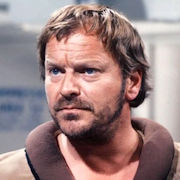
|
|
Planet Of Evil by Louis Marks, directed
by David Maloney
The Doctor and Sarah respond to a distress signal emanating from the
planet Zeta Minor, at the very edge of the universe. There they discover
that a research team has been systematically hunted down by an invisible
anti-matter monster. The only survivor is Professor Sorenson, who has
discovered a mineral which could serve as an almost limitless power
source. When a rescue mission led by Salamar also arrives on Zeta Minor,
the time travellers find themselves accused of murdering the scientific
expedition. The Doctor must find a way to convince Salamar of the truth
before Sorenson, corrupted by the anti-matter, dooms them all.
|

|
|
Pyramids Of Mars by Lewis Greifer,
directed by Paddy Russell
It is 1911, and the TARDIS lands in the home of sibling scientists
Marcus and Laurence Scarman. Something has happened to Marcus during an
archaeological dig in Egypt, and he has ordered the sinister Namin to
bar Laurence from the house. Furthermore, Laurence has begun detecting
strange radio signals from the surface of Mars. The Doctor discovers
that Marcus has become the avatar of Sutekh, a powerful alien Osirian
who has spent centuries imprisoned on Earth by his people as retribution
for his terrible crimes. Now Sutekh is using Marcus to regain his
freedom, heralding the end of the world.
|
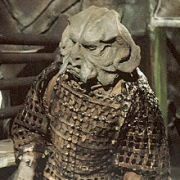
|
|
The Android Invasion by Terry Nation,
directed by Barry Letts
The TARDIS seems to have materialised near the modern-day English town
of Devesham, but something is very wrong. People in hazard suits attack
with guns in their fingers, the pub calendar repeats the same day again
and again, every coin is minted from the same date. Even the Doctor and
Sarah's friends from UNIT behave unnaturally. And, perhaps most
strangely, astronaut Guy Crayford is in charge of the nearby Space
Defence Station... but Crayford was lost in deep space years before. The
time travellers soon realise that they are not on Earth at all, but in a
simulacrum created by the Kraals as part of a plan to invade the Earth.
|

|
|
The Brain Of Morbius by Robin Bland,
directed by Christopher Barry
The Sisterhood of Karn tends a sacred flame, which provides an elixir
granting eternal life and which is used by the Time Lords to aid in
regenerative crises. The TARDIS arrives on Karn at a time when the
sacred flame is dying, and the Sisterhood accuses the Doctor of planning
to steal the last vestiges of the elixir. But also on Karn is the mad
neurosurgeon Mehendri Solon. He hides the brain of Morbius, an evil Time
Lord thought to have been executed. Solon is trying to build a new body
for Morbius, and is lacking only a suitable head... the head of a Time
Lord.
|

|
|
The Seeds Of Doom by Robert Banks
Stewart, directed by Douglas Camfield
An Antarctic expedition unearths two pods which the Doctor recognises as
Krynoids. Once germinated, the pods will infect humans, turning them
into giant carnivorous plants which will quickly overrun the world.
Already Winlett, one of the expedition members, has started to succumb
to the Krynoid taint. To make matters worse, the insane botanist
Harrison Chase has learned of the pods' existence and has despatched the
sadistic Scorby to obtain them. Even if the Doctor and Sarah are able to
stop the mutating Winlett in Antarctica, an even greater threat awaits
them at Chase's mansion in England...
|
|
With Doctor Who now consistently one of the BBC's most popular
programmes, a new problem reared its head in the form of Mary Whitehouse
and her National Viewers' and Listeners' Association. A self-appointed
media watchdog, Whitehouse had occasionally spoken out against violence
and horror in Doctor Who in the past. Now, however, with the
Hinchcliffe and Holmes encouraging these very elements, Whitehouse went
on the offensive. Her media campaign against Doctor Who would
ultimately contribute to the break-up of the successful production
team.
|
| Season Fourteen (1976-77):
Savagery |
| Companions and Recurring Characters |
|
Leela was a far-future human whose culture
had regressed to prehistorical standards, and who assisted the Doctor in
defeating the mad computer Xoanon.
Louise Jameson (bio) made her first appearance as
Leela in The Face Of Evil (January
1977) and her last in Dimensions In
Time (November 1993).
|
|
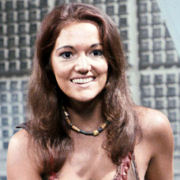
|

|
|
The Masque Of Mandragora by Louis Marks,
directed by Rodney Bennett
The TARDIS accidentally transports the Mandragora Helix, a malevolent
energy being, to Renaissance Italy. The Duke of San Martino has died
under mysterious circumstances, and the great thinkers of the fifteenth
century are coming to celebrate his son and heir, Giuliano. Desperate to
uncover the Helix's plans, the Doctor and Sarah forge an alliance with
Giuliano and his friend Marco. But the new Duke's uncle, Federico,
schemes to eliminate his nephew. He is assisted by the astrologer
Hieronymous, the secret leader of the cult of Demnos -- who has fallen
under the sway of the Mandragora Helix.
|
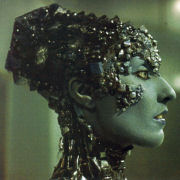
|
|
The Hand Of Fear by Bob Baker and Dave
Martin, directed by Lennie Mayne
The TARDIS lands in a quarry, where an explosion buries Sarah under
rock. When the Doctor rescues her, she is unconscious and clutching a
calcified hand. After awakening at the hospital, Sarah begins acting
strangely: the hand is all that remains of a silicon-based alien called
Eldrad, whose consciousness has seized control of Sarah's mind. Eldrad
compels her to break into a nearby nuclear complex and send the reactor
into meltdown. Even if the Doctor is able to avert a radioactive
catastrophe, can he save Sarah and put a stop to Eldrad's ancient plans?
|
An urgent summons to Gallifrey forces the Doctor to leave Sarah on
Earth.
|
|---|
|
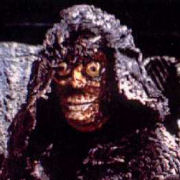
|
|
The Deadly Assassin by Robert Holmes,
directed by David Maloney
The Doctor has a premonition that he will assassinate the President of
the High Council of the Time Lords. Returning to Gallifrey, he finds
himself unable to prevent the murder, nor his own arrest. Only by
declaring his candidacy for the presidency does the Doctor buy the time
he needs to investigate, with the reluctant assistance of Castellan
Spandrell. The trail of clues leads to the Master: now disfigured, dying
and vengeful, he has somehow tapped into the extraordinarily advanced
computer network which guides the Time Lords. To stop his old enemy, the
Doctor must risk his life in the surreal landscape of the Matrix.
|
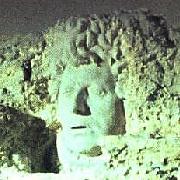
|
|
The Face Of Evil by Chris Boucher,
directed by Pennant Roberts
The rebellious warrior Leela is cast out of the Sevateem tribe after she
doubts the existence of their god, Xoanon. Left to fend for herself in a
phantom-plagued jungle, she meets the Doctor -- who is baffled when she
recognises him as the mythical Evil One. The Doctor manages to earn
Leela's trust by warding off the phantoms, and she brings him to a giant
carving of his own face in a mountainside. Returning to the Sevateem
village, the Doctor finds relics of advanced technology, and discovers
that the voice of Xoanon is his own. As the mystery unravels, the Doctor
realises that a past mistake is finally catching up to him...
|
Seeking adventure, Leela leaves with the Doctor.
|
|---|
|

|
|
The Robots Of Death by Chris Boucher,
directed by Michael E Briant
The TARDIS brings the Doctor and Leela to a Sandminer, a giant mining
ship. Most of its functions are maintained by robots: the mute Dums,
more advanced Vocs and highly sophisticated Super Vocs. The small human
crew has little to do except sit around in idle luxury... but now
they're being killed off, one by one. The lone clue to the killer's
identity is a corpse marker -- normally used to denote a deactivated
robot -- attached to each victim. Leela discovers a mysterious Super Voc
masquerading as a Dum, while the Doctor fears that they are in the midst
of a robot revolution. But is a human mind responsible?
|

|
|
The Talons Of Weng-Chiang by Robert
Holmes, directed by David Maloney
In Victorian London, girls are being kidnapped off the street, giant
rats haunt the sewers, and ghosts have been sighted in the opera house
run by impresario Henry Gordon Jago. When a mutilated body turns up in
the Thames, the Doctor and Leela find themselves investigating alongside
pathologist Dr Litefoot. The clues lead to a sinister mesmerist, Li
H'sen Chang, who is assisted by a murderous ventriloquist's dummy called
Mr Sin. Chang serves a man he believes is the god Weng-Chiang, and is
searching for a time cabinet lost by his master. Their quest leads them
to Litefoot -- and puts Leela's life in terrible danger.
|
|
Even as Doctor Who consistently enjoyed high ratings like never
before, Mary Whitehouse continued to campaign against its frightening
elements. After episode three of The Deadly
Assassin concluded with a lengthy freeze frame of the Doctor
being drowned, Whitehouse finally won an admission from the BBC that the
programme had gone too far. Behind the scenes, it was decided that
Philip Hinchcliffe should move on from Doctor Who, and that his
successor's approach should emphasise humour over horror.
|
| Season Fifteen (1977-78): A Lighter
Touch |
| Companions and Recurring Characters |
|
Wary of mounting criticism that Doctor Who was becoming too
frightening, the BBC replaced Philip Hinchcliffe with Graham Williams (bio). Instructed to tone down the
horror and violence, Williams concluded that his only option was to
place a renewed emphasis on humour. Robert Holmes, meanwhile, wanted to
return to scriptwriting full-time and so he was succeeded partway
through the season by Anthony Read (bio).
|
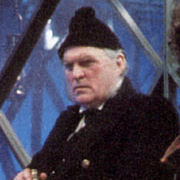
|
|
Horror Of Fang Rock by Terrance Dicks,
directed by Paddy Russell
Around the turn of the twentieth century, the TARDIS materialises near a
lighthouse on fog-shrouded Fang Rock in the English Channel. A power
outage plagues the lighthouse and Vince, a young keeper, believes that
it's connected to a strange light he saw in the sky. The Doctor
discovers that one of Vince's colleagues has been murdered but, before
he can investigate, a yacht capsizes near Fang Rock. Several
high-society passengers are rescued, and it becomes clear that they're
harbouring secrets of their own. Soon the body count starts to rise, and
the Doctor begins to suspect that the killer walks amongst them...
|

|
|
The Invisible Enemy by Bob Baker and
Dave Martin, directed by Derrick Goodwin
En route to a base on Titan in the year 5000, the crew of a spaceship is
infected with an intelligent, malignant virus. A distress signal from
Titan is picked up by the TARDIS, but the Doctor also becomes infected.
With his mind slowly succumbing the viral Nucleus, the Doctor places
himself in a coma. Leela helps him reach a medical facility called the
Bi-Al Foundation, where they meet Professor Marius and his robot dog,
K·9. Marius creates clones of the Doctor and Leela, whom he
miniaturises and injects into the Time Lord's body. They plan to travel
into the Doctor's brain and take the battle to the Nucleus itself.
|
Professor Marius gives K·9 to the Doctor and Leela.
|
|---|
|

|
|
Image Of The Fendahl by Chris Boucher,
directed by George Spenton-Foster
Strange events haunt the village of Fetchborough. At the old Priory,
scientists led by Dr Fendelman study a skull which is millions of years
older than the earliest man. In the woods, a hiker is killed by
something creeping through the night. Nearby, the TARDIS arrives, drawn
by the activation of a time scanner. While Leela finds reluctant allies
in the form of a local wise woman and her grandson, the Doctor discovers
that one of the scientists, Thea Ransome, is being groomed for a
sinister ritual. If successful, it will resurrect an ancient embodiment
of death -- one thought destroyed by the Time Lords long ago.
|
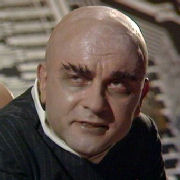
|
|
The Sun Makers by Robert Holmes,
directed by Pennant Roberts
The TARDIS lands on far-future Pluto, which the Doctor is astonished to
find orbited by miniature suns and inhabited by humans toiling for the
Company. After rescuing a worker named Cordo from suicide, the time
travellers learn that the Company keeps humanity crushed by oppressive
taxation. They decide to seek out the rebels who lurk in the undercity
beneath Megropolis One -- not realising that they have aroused the
suspicions of the odious Gatherer Hade, who serves the sinister
Collector. To make matters worse, the rebels lure the Doctor into a
trap... and Leela's attempts to rescue him may have deadly consequences.
|
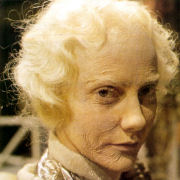
|
|
Underworld by Bob Baker and Dave Martin,
directed by Norman Stewart
The Doctor, Leela and K·9 find themselves aboard the R1C, a
spacecraft from the doomed Minyan civilisation, which destroyed itself
using technology given to them by early Time Lords. For a hundred
thousand years, Jackson and his three-person crew have been searching
for the P7E, the ship carrying the Minyan race banks, with which
they hope to revive their people. The Doctor helps them trace the
P7E to a spiral nebula, where space debris has formed a planet
around it. But, on penetrating to the planet's core, they discover a
downtrodden people -- the Trogs -- who suffer under the rule of the
unseen Oracle.
|

|
|
The Invasion Of Time by David Agnew,
directed by Gerald Blake
The Doctor returns to Gallifrey, having made a deal with aliens known as
the Vardans to ensure that he will ascend to the presidency of the High
Council of the Time Lords. Behaving erratically, the Doctor alienates
his old friend, Chancellor Borusa, and forms an alliance with the
duplicitous Castellan Kelner. Then he has Leela exiled to the wastes
beyond the Capitol, where she takes refuge with a group of outcast
Gallifreyans living as savages. Leela believes that the Doctor has
turned traitor. In fact, he is orchestrating an elaborate scheme to
unveil the identity of the Vardans' masters -- and foil a plot to invade
Gallifrey itself.
|
Leela remains on Gallifrey to marry Commander Andred of the Chancellery
Guard and K·9 stays with her, while the Doctor activates K·9
Mark II.
|
|---|
|
|
Season Fifteen saw an attempt not to just to lighten the atmosphere of
Doctor Who but also to turn it back into more of a family show
than it had been during the preceding three years. This was most
apparent in the introduction of K·9, a character designed to appeal
primarily to younger children. In response, Mary Whitehouse's attacks on
Doctor Who finally abated, and such criticisms would not
routinely plague the programme again until 1985.
|
| Season Sixteen (1978-79): The Quest For The
Key To Time |
| Companions and Recurring Characters |
|
The first incarnation of the Time Lady Romanadvoratrelundar -- called
Romana for short -- was despatched by the
White Guardian to assist the Doctor in his quest for the Key To
Time.
Mary Tamm (bio) made her first appearance as Romana
in The Ribos Operation (September
1978) and her last in The Armageddon
Factor (February 1979).
|
|

|
|
The Black Guardian was a cosmic force
embodying chaos, the antithesis of the order and balance represented by
the Doctor's patron, the White Guardian.
Valentine Dyall (bio) made his first appearance as
the Black Guardian in The Armageddon
Factor (February 1979) and his last in Enlightenment (March 1983).
|
|
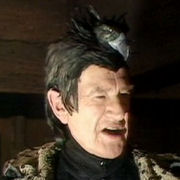
|

|
|
The Ribos Operation by Robert Holmes,
directed by George Spenton-Foster
The Doctor is called upon by the White Guardian, the embodiment of order
and light, to find the six hidden segments of the Key To Time --
scattered throughout time and space -- so that the faltering universal
balance can be restored. The first destination is the wintry, mediaeval
planet of Ribos, where the Doctor soon discovers that a piece of the
priceless mineral jethrik is really a segment of the Key in disguise.
But the jethrik is part of a scheme being perpetrated by the wily Garron
and his confederate, Unstoffe, to swindle a fortune from the
megalomaniacal Graff Vynda-K... and the Doctor is soon embroiled in the
con.
|
The White Guardian sends Romana to help the Doctor find the Key To Time.
|
|---|
|

|
|
The Pirate Planet by Douglas Adams,
directed by Pennant Roberts
The Doctor and Romana head to the planet Calufrax in search of the
second segment of the Key To Time. Inexplicably, however, the TARDIS
lands on Zanak, a world of seemingly limitless mineral wealth, ruled by
the crazed Captain. Zanak is haunted by the Mentiads, a group of
telepaths whose numbers swell each time a new golden age of prosperity
is proclaimed. While Romana is captured by the Captain, the Doctor tries
to help Mula, whose brother has been taken by the Mentiads. His
investigation leads to the grim discovery that Zanak owes its riches to
a wake of destruction on a planetary scale -- and to the deaths of
billions.
|

|
|
The Stones Of Blood by David Fisher,
directed by Darrol Blake
The quest for the third segment of the Key To Time takes the TARDIS to
modern-day Earth, near a stone circle called the Nine Maidens. A druidic
cult led by the sinister De Vries is performing blood rituals
there, honouring a Celtic goddess called the Cailleach. At the same
time, archaeologist Emilia Rumford and her assistant, Vivien Fay, are
investigating strange flaws in previous surveys of the circle. Left
alone at the Nine Maidens, Romana is nearly driven over a cliff by an
apparition which takes the Doctor's form. Meanwhile, the
Doctor discovers that the monoliths are actually monstrous Ogri, in
service to an ancient villain...
|

|
|
The Androids Of Tara by David Fisher,
directed by Michael Hayes
While the Doctor relaxes, Romana finds the fourth segment of the Key To
Time on the planet Tara. She is then kidnapped by the villainous Count
Grendel, who has mistaken her for an android duplicate of Princess
Strella, whom he also holds prisoner. Grendel has aspirations to the
Taran throne, to which Strella is second in line. He plans to undermine
the claim of the heir apparent, Prince Reynart, then marry Strella. But
with the princess unwilling to cooperate, Grendel now intends to compel
Romana to take her place. Meanwhile, the Doctor allies himself with
Reynart in a desperate attempt to stop Grendel's bid for power.
|

|
|
The Power Of Kroll by Robert Holmes,
directed by Norman Stewart
On the marshy third moon of Delta Magna, the Doctor and Romana obtain
strange readings as they hunt for the fifth segment of the Key To Time.
Their search is complicated by tensions between the primitive Swampies
-- the native species of Delta Magna, long ago relocated to the moon by
human colonists -- and the crew of a new refinery. Intent on war, the
Swampies have sought the help of gun-runner Rohm-Dutt, unaware that he
plans to supply them with faulty weaponry. As hostilities escalate, the
Swampie god -- a gargantuan squid named Kroll -- rises from the marsh,
to wreak untold destruction.
|

|
|
The Armageddon Factor by Bob Baker and
Dave Martin, directed by Michael Hayes
The Black Guardian, embodiment of evil and darkness, looms as the search
for the final segment of the Key To Time brings the TARDIS to Atrios.
There, the time travellers find the zealous Marshal determined to win a
protracted war with the neighbouring world of Zeos, even as the beloved
Princess Astra struggles to hold her people together. But Astra goes
missing, while Romana discovers that the Marshal is being influenced by
an unknown force. A journey to Zeos reveals a barren world governed only
by the computer Mentalis. At the heart of the mystery is the sinister
Shadow... and his own quest for the Key To Time.
|
|
An idea Graham Williams had tried and failed to implement during his first
year as producer was that of an overarching theme running through every
story of the season. This finally came about during Season Sixteen, with
the Doctor's quest for the Key To Time playing a role in all six
adventures.
|
| Season Seventeen (1979-80): The Time
Traveller's Guide To The Galaxy |
| Companions and Recurring Characters |
|
Despite having completed the quest for the Key To Time, Romana chose to continue travelling with the Doctor
in a regenerated body.
Lalla Ward (bio) made her first appearance as Romana
in Destiny Of The Daleks (September
1979) and her last in Dimensions In
Time (November 1993).
|
|

|
|
Anthony Read left Doctor Who at the end of Season Sixteen. His
replacement was the inexperienced but enormously creative Douglas Adams (bio), who had written The Pirate Planet the previous year.
He fostered the vein of comedy preferred by Tom Baker and Lalla Ward,
but found himself overwhelmed by work due to the success of his
creation, The Hitchhiker's Guide To The Galaxy.
|
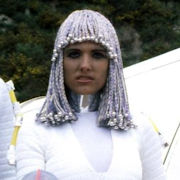
|
|
Destiny Of The Daleks by Terry Nation,
directed by Ken Grieve
Having installed a Randomiser in the TARDIS to prevent the Black
Guardian from tracking them, the Doctor and the newly-regenerated Romana
find themselves on a strangely-familiar planet. Separated from the
Doctor by a rockfall, Romana is captured by those responsible: the
Daleks, who force her into slave labour. Meanwhile, the Doctor meets the
coldly beautiful Movellans who reveal that the TARDIS has landed on
Skaro, the Daleks' abandoned homeworld. The Doctor agrees to help the
Movellans uncover the object of the Daleks' search -- which turns out to
be none other than their long-lost creator, Davros.
|
Romana regenerates into her second incarnation.
|
|---|
|
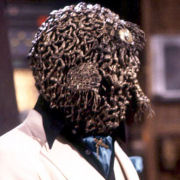
|
|
City Of Death by David Agnew, directed
by Michael Hayes
On primordial Earth, a spaceship carrying the alien Scaroth explodes. In
modern-day Paris, the Doctor and Romana trace disturbances in time to
the urbane Count Scarlioni. They meet a private detective named Duggan,
who believes that Scarlioni is responsible for a spate of lost objets
d'art being sold on the black market. They realise that this is how
he is funding experiments with time. Scarlioni is now planning to steal
the Mona Lisa from the Louvre and sell six perfect copies. The
Doctor travels back to 1505 to unearth the origin of the duplicates --
only to discover that, somehow, Leonardo da Vinci's patron is Scarlioni
himself.
|

|
|
The Creature From The Pit by David
Fisher, directed by Christopher Barry
The planet Chloris is plentiful in vegetation but almost barren of
metal. The Doctor, Romana and K·9 arrive in response to a distress
signal, which appears to be coming from an enormous metallic shell. They
are captured by Chloris' leader, the wicked Lady Adrasta, who has the
Doctor thrown into a deep pit. Although he survives the fall, he finds
himself in tunnels which are reputed to be the home of an immense green
monster. With the help of the elderly astrologer Organon, the Doctor
sets out to discover the creature's origins -- even as Adrasta plots to
use K·9 to destroy her enemies once and for all.
|
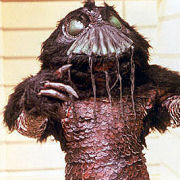
|
|
Nightmare Of Eden by Bob Baker, directed
by Alan Bromly and Graham Williams
En route to the planet Azure aboard the spaceliner Empress are
the scientist Tryst and his assistant Della. They are transporting
samples of various worlds within a Continuous Event Transmuter. But the
Empress comes out of warp at the wrong coordinates and fuses with
another ship, the Hecate. When the TARDIS materialises aboard the
Empress, the Doctor and Romana offer to help, but their efforts
are imperiled by the monstrous Mandrels, who stalk the interface between
the two vessels. To make matters worse, the Doctor begins to suspect
that the Empress is part of a scheme to smuggle vraxoin -- an
illicit, highly addictive drug.
|

|
|
The Horns Of Nimon by Anthony Read,
directed by Kenny McBain
Skonnos was once the centre of a galactic empire and, although it has
fallen into decay, it is still paid a regular tribute of seven youths
from the planet Aneth. They are destined to be sacrificed to the Nimon,
a bull-like alien who dwells within a vast power complex. In return, the
Nimon has offered Soldeed, leader of the Skonnans, the ability to forge
a new empire. When the Doctor and Romana find the ship carrying the
Anethan tribute floating derelict in space, they are forced to help
effect repairs. Romana is taken captive, while the Doctor discovers
evidence that the Nimon's promises to Soldeed hide a far more terrible
plan.
|
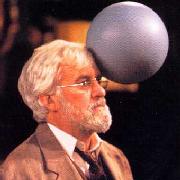
|
|
Shada by Douglas Adams, directed by
Pennant Roberts
The Doctor, Romana and K·9 visit an old friend, a retired Time Lord
named Chronotis. Now living as a professor at Cambridge University,
Chronotis wishes to return a book he took from Gallifrey. But the book
has been inadvertently acquired by two college students, Chris Parsons
and Clare Keightley, who discover that it does strange things to time.
Also in pursuit of the book is the evil scientist Skagra, who uses his
technology to drain the knowledge from Chronotis' mind. Before he dies,
Chronotis gives Romana a mysterious warning... but what is Shada?
(This story was never completed or broadcast due to industrial
action.)
|
|
Although Doctor Who had been threatened by labour disputes in the
past, never had a story actually been cancelled due to industrial action
until Season Seventeen. Sadly, the loss of Shada meant that departing
producer Graham Williams' era finished on an abrupt and unplanned note.
It was a gloomy end to a year which had enjoyed the heights of Doctor
Who's first-ever overseas location filming -- for City Of Death -- but also saw the
programme's budget severely compromised by skyrocketing inflation.
|
| Season Eighteen (1980-81): Change And
Decay |
| Companions and Recurring Characters |
|
Adric was a teenaged mathematical genius
who stowed away aboard the TARDIS after helping the Doctor solve the
mystery of his home planet, Alzarius.
Matthew Waterhouse (bio) made his first appearance
as Adric in Full Circle (October
1980) and his last in The Caves Of
Androzani (March 1984).
|
|
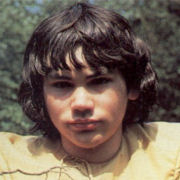
|
|
Nyssa, the daughter of nobility on the
planet Traken and a gifted scientist, joined the Doctor after her father
was murdered by the Master.
Sarah Sutton (bio) made her first appearance as
Nyssa in The Keeper Of Traken
(January 1981) and her last in Dimensions
In Time (November 1993).
|
|
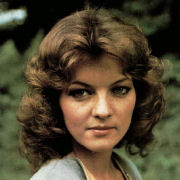
|
|
The evil Time Lord known as the Master was
reinvigorated after stealing a human body, and embarked on a new spree
of villainy across space and time.
Anthony Ainley (bio) made his first appearance as
the Master in The Keeper Of
Traken (February 1981) and his last in Survival (December 1989).
|
|
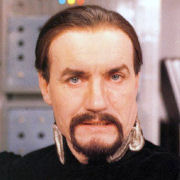
|
|
Tegan Jovanka was a flight attendant for
Air Australia who wandered into the TARDIS when it was parked in 1980s
London.
Janet Fielding (bio) made her first appearance as
Tegan in Logopolis (February 1981)
and her last in The Power Of The
Doctor (October 2022).
|
|
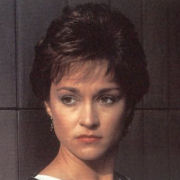
|
|
As Doctor Who headed into the Eighties, its course was charted by
an all-new production team. The producer was former production unit
manager John Nathan-Turner (bio), who would go on to serve
in this capacity for the entire decade. His script editor was Christopher H Bidmead (bio). They were overseen by
former producer Barry Letts (bio), who was installed as executive
producer to provide support for the inexperienced Nathan-Turner. In
addition to implementing a visual overhaul of Doctor Who, the new
team's philosophy was that the programme had become too fantastical in
recent years, and they strove for an emphasis on legitimate scientific
principles.
|
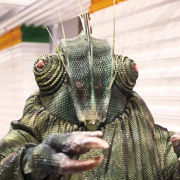
|
|
The Leisure Hive by David Fisher,
directed by Lovett Bickford
The Doctor and Romana travel to the Leisure Hive on Argolis, a planet
ravaged by a nuclear war with the Foamasi years earlier. The Argolin
leader, Mena, explains that her people are now sterile and the Hive is
their legacy, intended to bring different races together in the spirit
of peace. The main attraction is a device called the Tachyon
Recreation Generator, but it is experiencing mysterious faults. At the
same time, Mena's son, Pangol, becomes increasingly militant; the
scientist Hardin conducts fraudulent temporal experiments; an Earth
businessman, Brock, behaves very oddly; and mysterious creatures prowl
the Leisure Hive.
|
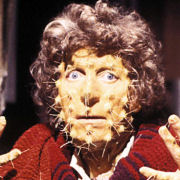
|
|
Meglos by John Flanagan and Andrew
McCulloch, directed by Terence Dudley
The Doctor's old friend Zastor summons him back to the planet Tigella,
where the population is divided between the zealous Deons and the
scientific Savants. Something is going wrong with the Dodecahedron,
Tigella's main power source, but the Deons have forbidden the Savants
from investigating. Meanwhile, on the nearby world of Zolfa-Thura, a
group of mercenaries revives the ruined planet's last survivor: the
cactus-like Meglos. The shapeshifting Meglos steals the Doctor's form
and traps the TARDIS in a time loop. He then travels to Tigella, where
his goal is to steal the Dodecahedron -- and frame the Doctor for the
crime.
|
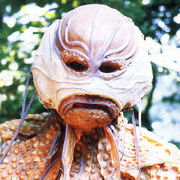
|
|
Full Circle by Andrew Smith, directed by
Peter Grimwade
Romana is recalled to Gallifrey, only for the TARDIS to be drawn into
another universe called E-Space. The time travellers land on the planet
Alzarius, where a Starliner from Terradon crashlanded long ago.
Generations later, the ship is still being repaired, but now the dreaded
time of Mistfall has arrived, during which savage Marshmen rise from the
swamps. While the ruling Deciders seal most of their people aboard the
Starliner, Romana meets the renegade Outlers, who refused to heed the
summons. The Doctor sneaks aboard the ship, where he discovers that the
Deciders are harbouring terrible secrets.
|
Adric, one of the Outlers, stows away on board the TARDIS.
|
|---|
|
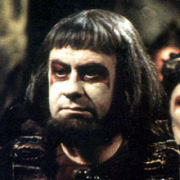
|
|
State Of Decay by Terrance Dicks,
directed by Peter Moffatt
Still trapped in E-Space, the TARDIS materialises near a mediaeval
village. The townsfolk live in fear of the Three Who Rule, who govern
from their mighty Tower. Bats serve as their minions, science is
forbidden, and youth are periodically taken from the village, never to
be seen again. The Doctor and Romana meet a group of rebels who have
discovered ancient equipment from an Earth spaceship. They realise that
the Tower is the ship, and the Three Who Rule are somehow identical to
the original crew. Meanwhile, Adric is the latest to be selected by Lord
Aukon... and, beneath the Tower, something vast and terrible stirs.
|

|
|
Warriors' Gate by Steve Gallagher,
directed by Paul Joyce
Trying to escape from E-Space, the Doctor, Romana, Adric and K·9
instead land in an eerie white void whose only feature is a crumbling
archway. Also trapped in the void is a privateering ship captained by
the cruel Rorvik. When the ship's time-sensitive Tharil pilot -- the
leonine Biroc -- escapes, Rorvik has Romana captured and pressed into
service as their new navigator. Meanwhile, Biroc lures the Doctor
through the archway and into a long-abandoned banquet hall. There,
mirrors act as gateways, robotic Gundans wait to attack, and a terrible
secret history will be revealed.
|
Romana and K·9 remain in E-Space to help free the captive Tharil race.
|
|---|
|

|
|
The Keeper Of Traken by Johnny Byrne,
directed by John Black
The Traken Union is governed by a Keeper gifted with the fantastic
powers of the Source. The current Keeper's abilities are waning as he
nears the end of his thousand-year tenure, and he asks the Doctor and
Adric -- who have escaped from E-Space -- to stop an evil he believes
has taken root on Traken. But the statue-like Melkur has already
corrupted Kassia, one of the ruling Consuls. The Doctor and Adric stand
accused of murder, and are saved only by the intervention of Kassia's
husband, Consul Tremas, and his daughter, Nyssa. Together, they must
unmask the villain behind the Melkur and safeguard the Source.
|
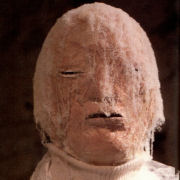
|
|
Logopolis by Christopher H Bidmead,
directed by Peter Grimwade
The Doctor decides to travel to Logopolis -- where pure mathematics can
be used to reshape reality -- in order to repair the TARDIS and
reactivate its chameleon circuit. First he goes to Earth to locate a
real police box, and finds himself observed by a mysterious Watcher.
Airline stewardess Tegan Jovanka stumbles into the TARDIS, unaware that
her Aunt Vanessa has become the Master's latest victim. She travels to
Logopolis with the Doctor and Adric, and there they are met by Nyssa,
who is searching for her missing father. But it soon becomes clear that
Logopolis itself is another part of the Master's apocalyptic trap...
|
The Fourth Doctor, now joined in his travels by Nyssa and Tegan, falls
from atop the Pharos Project telescope and regenerates.
|
|---|
|
|
Season Eighteen's stylistic changes saw Doctor Who stride
confidently into the Eighties, much as Season Seven's new direction had
ushered it into the Seventies. With a flashier title sequence,
higher-concept stories, more accessible companions, and a renewed
emphasis on production values, Doctor Who had undergone a
complete facelift. Only dwindling ratings in the wake of fiercer
competition dimmed the shine of the revamped programme. Nonetheless,
with the end of the season witnessing the departure of Tom Baker -- the
longest-serving Doctor -- the slate was wiped clean for a brand new
era.
|
|